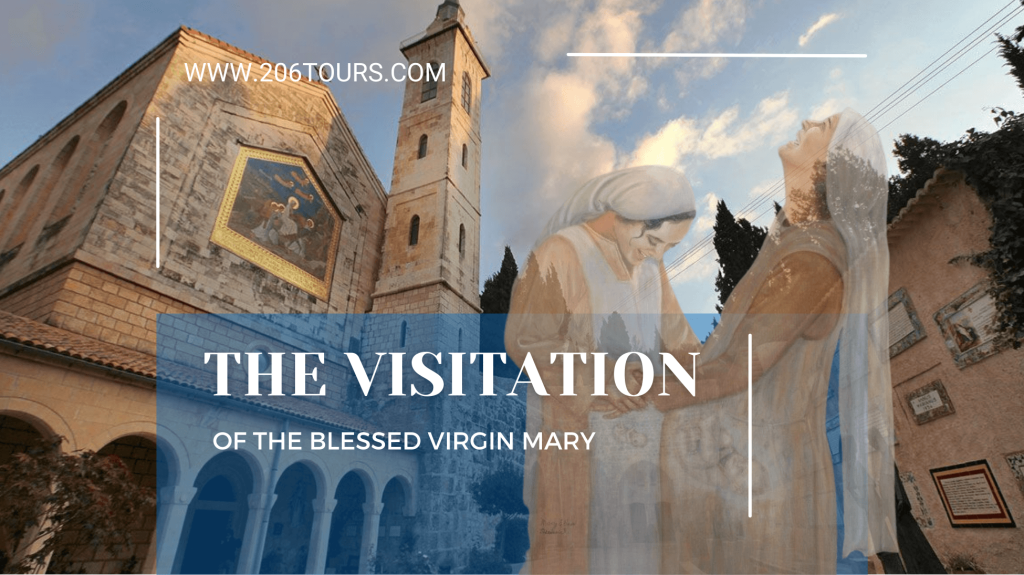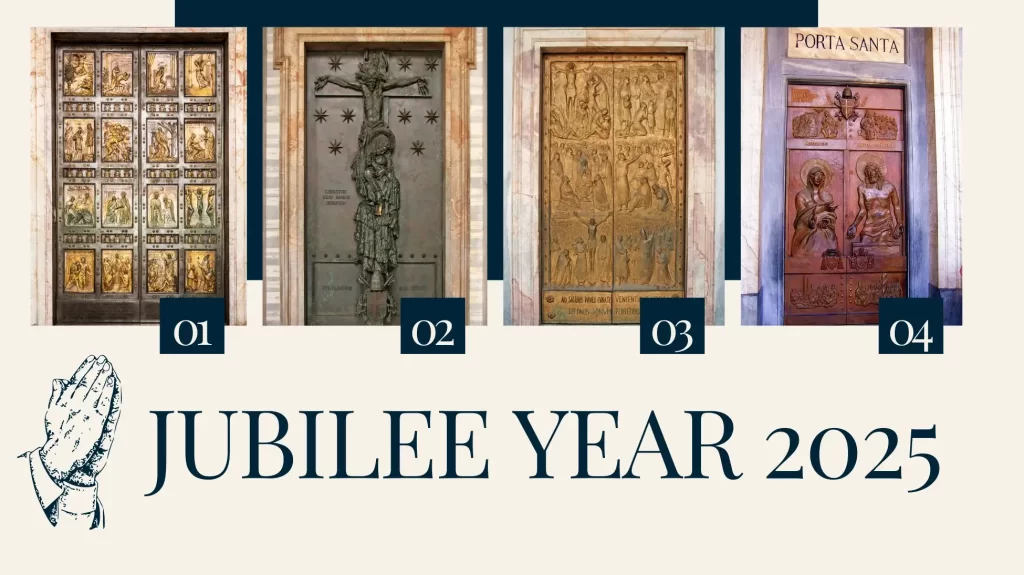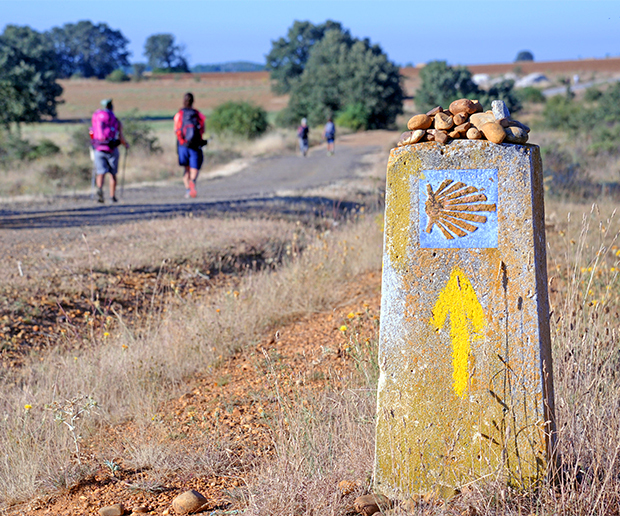Month: May 2023

Nestled in the mountain village of Ein Karem, meaning “spring of the vineyard,” is the Church of Visitation. We visit this sacred site on our Holy Land tours, honoring the place where our Mother sang her great Magnificat. Mary praised the Lord at the end of her tiring trek through the wilderness for being faithful to her people and for choosing her to carry out His plan of salvation. This was not only the end of her personal journey to the home of Zechariah and Elizabeth, but the end of her people’s journey waiting for the Lord to come. The title of Elizabeth’s home village is fitting. A vineyard is a place of waiting for the ground to rest and for fruit to blossom. Mary’s visitation was the spring at the end of a long winter. Her people had been waiting for the Messiah for centuries, and finally He was in their midst in the holy womb of our Blessed Mother.
The first thing Mary was inspired to do after being made aware of the presence of God within her was to make a journey. If you feel like you are waiting for fruit to blossom, consider visiting a holy place in our Church’s tradition. The second option for the first reading today urges us to “not grow slack in zeal” (Romans 12:11). We are so comfortable in today’s world; perhaps God is calling us to go elsewhere—to take Christ to people of foreign lands and indeed to find Him in the hearts and lands of strangers.
Walking ancient roads, praying in the same places as the great saints, and growing in holiness alongside other pilgrims from around the world teaches us firsthand that our God “has mercy on those who fear Him in every generation” (Luke 1:50). The universal Church is supposed to be just that: universal. Mary left her home to sing God’s praises to others, and her fellow lover of God encouraged her in her calling. The second reading also talks about how we are to be a Church: rejoicing and weeping with one another—having “the same regard for one another” just like Mary and Elizabeth did (Romans 12:16). Pilgrimages are not a vacation or a luxury, they are an essential chamber of the heart of faith. They are an effort to dedicate ourselves wholeheartedly to the knowledge of God and the life of our Church. They are a passionate prayer of love. May we all embrace the Holy Spirit’s inspiration for us to go wherever He is calling us to visit, and may we go “in haste” (Luke 1:39).
View the Full 206 Tours Pilgrimage Directory: www.206tours.com/pilgrimages

The next Catholic Jubilee year will be in 2025, inspiring Catholics and even those from other faith traditions to make plans to visit the Eternal City. 2025 marks 25 years since the great Jubilee of 2000 with Pope Saint John Paul II, and 10 years since the extraordinary 2015 Jubilee Year of Mercy declared by Pope Francis. The Pope will lead his second Jubilee, giving it the theme “Pilgrims of Hope,” beginning just before Christmas day 2024 and ending on the feast of the Epiphany in 2026. Pilgrims may want to pay heed to the following special dates:
- January 24, 2025: Jubilee of the World of Communication
- February 15, 2025: Jubilee of Artists
- April 5, 2025: Jubilee of the Sick and the World of Health Care
- May 1, 2025: Jubilee of Workers
- May 30, 2025: Jubilee of Families
- July 28, 2025: Jubilee of Youth
- October 11, 2025: Jubilee of Marian Spirituality
Pope Boniface VIII instituted the first Jubilee year in 1300, and it was to be celebrated every 100 years in the Church. This was then changed to every 50 years to follow biblical tradition (Leviticus 25), and was at last changed by Pope Paul II in 1490 to be every 25 years. The Holy Year of 2025 will be the 27th ordinary Jubilee of the Catholic Church.
As can be read in Leviticus 25, a Jubilee year is a year of atonement and mercy. It is a time when debts are forgiven and conversion is widespread. It is a time set apart for the Lord, when all His people turn to Him and He bestows abundant graces. For this reason, Jubilee years are marked by the opening of the Holy Doors. These beautiful, large doors can be found in the four major basilicas of Rome: St. Peter’s, St. John Lateran, St. Mary Major, and St. Paul Outside the Walls. These doors are only opened during Jubilee years. The doors at St. Peter’s will be opened first, to signify the open arms of the Church to her broken yet beloved faithful. Prayerful pilgrims obtain graces by walking through these doors, and by practicing a few other devotions, they may obtain the Jubilee plenary indulgence.
A plenary indulgence is the total remission of the punishment due to sin for oneself or for a deceased soul. The sacrament of penance remits the guilt of sin, while an indulgence remits its temporal punishments. The requirements for obtaining a plenary indulgence are as follows:
- Have the intention of gaining indulgence
- Receive the Sacrament of Penance
- Receive the Eucharist
- Pray for the Intentions of the Pope
- Be free from all attachment of Sin
- Perform the prescribed action of Indulgence
The prescribed action for the Jubilee indulgence varies depending on where you are. There are actions you can do in your own diocese, but in Rome you can visit one of the four major basilicas. You can also obtain the indulgence by venturing to the Holy Land and visiting the Basilica of the Holy Sepulchre in Jerusalem, the Basilica of the Nativity in Bethlehem, or the Basilica of the Annunciation in Nazareth.
On top of the opening of the holy doors, there will be many exciting activities and exhibits for pilgrims to engage in. The Vatican has launched a website and a Jubilee app in order to help pilgrims prayerfully and successfully navigate their preparation for this year. Beginning in September, you can register online and get access to the “pilgrim zone” and receive a special digital “pilgrim’s card” that will get you access to Jubilee events. The Vatican is currently preparing and already has several special exhibitions lined up, and it is expected that the Shroud of Turin will also be on display. We will keep you posted.
Please join 206 Tours as we celebrate our 40th year for the pilgrimage of a lifetime in the Jubilee year of Hope, 2025! If you are interested in arranging a group pilgrimage, please let us know as soon as possible as we expect that 2025 will be very busy! We hope to see you there!
View the Full 206 Tours Pilgrimage Directory: www.206tours.com/pilgrimages

El Camino de Santiago is a Catholic pilgrimage unique for its spiritual significance, not unrelated to its challenging elements. The Way of Saint James is different from other Catholic pilgrimages but you do not need to fear its difficulties! With these helpful tips for the various aspects of this trip, you will surely have a beautiful journey.
- A practical tip for walking El Camino is to learn some key phrases from the countries you will travel through, such as in Spanish, Portuguese, or French. Your tour guide will be happy to help you with this part, but it can add some fun to the trip if you come prepared! Hello, thank you, and excuse me/ I’m sorry are a few important ones. Wish all pilgrims you pass a “buen camino” as well!
- A great emotional tip for your journey ahead is to be self-aware and honest with yourself. The pilgrimage can be physically and emotionally taxing, and the more gentle you are with yourself, the more you will be able to be open to the mercy and tenderness of God. Slow down and take breaks when you need to. Do not compare yourself to other pilgrims. This is your journey, so make sure to celebrate every step!
- The physical element of traveling El Camino is the most well-known challenge, but preparation does not need to be complicated! Walking pilgrimages require some amount of endurance, which can be built up by taking a walk for an hour or two every day, and then taking a 3-4 hour hike once a week. Walking days vary anywhere from 4 to 18 miles, and the better your body is prepared, the more you will be able to enjoy the beautiful scenery.
- As for the communal aspect of the pilgrimage, be honest with your group and set healthy boundaries. Though you will be able to branch off from the 206 Tours group, if you are traveling with family or friends, make sure you communicate. One pilgrim, Father Joseph Paul, O.P., recommends friend groups and family members traveling together to set expectations and ground rules before embarking on this journey. His family set a “right of refusal of conversation,” so that anyone was allowed to say “I don’t want to talk right now” when they weren’t feeling up to it. Be upfront with those around you, and always communicate your needs!
- Finally, set reasonable expectations for the central spiritual element of the Way of Saint James. Father Joseph Paul advises, “Don’t force the fruits of the pilgrimage, a lot of them come afterwards.” At the end of the day, when you are mentally and physically exhausted, don’t expect a world of consolation right then. Your life looks very different when you are on a walking pilgrimage, and so will your daily meditation. Trust that God will give you the graces you need for each day, and that great growth often comes in simple ways, step by step.
With these tips in mind, 206 Tours wants to encourage every Catholic planning to join us for El Camino de Santiago to ready yourself for this life changing road ahead. Rest assured, however, that we will be there to guide you through anything you are unprepared for. Buen Camino!
Click here to view our incredible El Camino Pilgrimage: www.206tours.com/tour70

View the Full 206 Tours Pilgrimage Directory: www.206tours.com/pilgrimages
